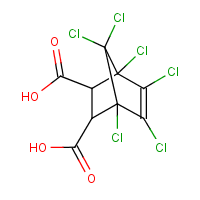Chlorendic acid
Agent Name
Chlorendic acid
CAS Number
115-28-6
Formula
C9-H4-Cl6-O4
Major Category
Other Classes

Synonyms
1,4,5,6,7,7-Hexachloro-5-norbornene-2,3-dicarboxylic acid; 1,4,5,6,7,7-Hexachlorobicyclo(2.2.1)-5-heptene-2,3-dicarboxylic acid; 5-Norbornene-2,3-dicarboxylic acid, 1,4,5,6,7,7-hexachloro-; Chlorendic acid (VAN); HET acid; Hexachloro-endo-methylenetetrahydrophthalic acid; Hexachloroendomethylenetetrahydrophthalic acid; Kyselina 1,2,3,4,7,7-hexachlorbicyklo(2,2,1)hept-2-en-5,6-dikarboxylova [Czech]; Kyselina 3,6-endomethylen-3,4,5,6,7,7-hexachlor-delta(sup 4)-tetrahydroftalova [Czech]; Kyselina 3,6-endomethylen-3,4,5,6,7,7-hexachlor-delta(sup 4)-tetrahyroftalova [Czech]; Kyselina het [Czech]; [ChemIDplus]
Category
Organic Acids
Description
White odorless solid; [CAMEO]
Sources/Uses
Used as a fire-retardant monomer in unsaturated polyester resins, wool fabrics, coatings, epoxy resins, and polyurethane foams; Also used as an extreme pressure lubricant, chemical intermediate, and for special applications in electronic systems, paneling, engineering plastics, paints, and anti-corrosion tanks, pipes, and other equipment; [HSDB]
Comments
A skin irritant; A severe eye and respiratory tract irritant (based on animal studies); [HSDB] A skin, eye, and mucous membrane irritant; [CAMEO] Closely related to chlorendic anhydride; The acid loses water and forms the anhydride when heated in an open system, and the anhydride can be hydrolyzed to the acid; Workers exposed to the anhydride are likely to be also exposed to the acid; Inhalation exposure to the heated acid at 100 deg C caused lacrimation, irregular breathing, and severe pulmonary irritation in rats; [Reference #1] See "Chlorendic anhydride."
Reference Link #1
Biomedical References
Exposure Assessment
Vapor Pressure
3.04E-08 mm Hg
Lethal Concentration
LC50 (rat) > 790 mg/m3/4h
Adverse Effects
Lachrymator
Yes
IARC Carcinogen
Possible (2b)
NTP Carcinogen
Anticipated human carcinogen
Diseases, Processes, and Activities Linked to This Agent
Processes
Industrial Processes with risk of exposure: